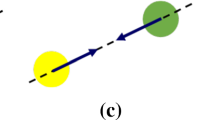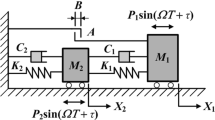Abstract
In multibody simulation, the Gear–Gupta–Leimkuhler method or stabilized index 2 formulation for persistent contacts enforces constraints on position and velocity level at the same time. It yields a robust numerical discretization of differential algebraic equations avoiding the drift-off effect and is often more effective than decreasing the time step size to preserve geometric characteristics. In this work, we carry over these benefits to impacting mechanical systems with unilateral constraints. For this kind of a mechanical system, adding the position level constraint to an (event-capturing) timestepping scheme on velocity level even maintains physical consistency of the impulsive discretization. Hence, we propose a timestepping scheme based on Moreau’s midpoint rule, which enables to achieve not only compliance of the impact law, but also of the nonpenetration constraint. The choice of a decoupled and consecutive evaluation of the respective constraints can be interpreted as a not energy-consistent coordinate projection to the nonpenetration constraint at the end of each time step. It is the implicit coupling of position and velocity level, which yields satisfactory results. An implicit evaluation of the right hand side improves stability properties without additional cost. With the prox function formulation, the overall set of nonsmooth equations is solved by a nonsmooth Newton method. Results from simulations of a slider-crank mechanism with unilateral constraints demonstrate the capability of our approach.










Similar content being viewed by others
References
Acary, V.: Projected event-capturing time-stepping schemes for nonsmooth mechanical systems with unilateral contact and Coulomb’s friction. Research Report RR-8029, INRIA (2012). http://hal.inria.fr/hal-00720747
Acary, V., Bonnefon, O.: Time integration of nonsmooth mechanical systems with unilateral contact. conservation and stability of position and velocity constraints in discrete time. In: Proceedings of 7th European Nonlinear Oscillation Conference, Rome, 24th–29th July 2011
Acary, V., Brogliato, B.: Numerical Methods for Nonsmooth Dynamical Systems: Applications in Mechanics and Electronics, 1st edn. Lecture Notes in Applied and Computational Mechanics, vol. 35. Springer, Berlin (2008)
Alishenas, T., Olafsson, O.: Modeling and velocity stabilization of constrained mechanical systems. BIT Numer. Math. 34, 455–483 (1994)
Arnold, M.: Numerical methods for simulation in applied dynamics. In: Arnold, M., Schiehlen, W. (eds.) Simulation Techniques for Applied Dynamics. CISM International Centre for Mechanical Sciences, vol. 507, pp. 191–246. Springer, Wien (2009)
Brogliato, B.: Nonsmooth Mechanics: Models, Dynamics and Control, 2nd edn. Communications and Control Engineering. Springer, London (1999)
Deuflhard, P.: Newton Methods for Nonlinear Problems: Affine Invariance and Adaptive Algorithms, corr. 2nd printing edn. Springer Series in Computational Mathematics, vol. 35. Springer, Berlin (2006)
Eich, E., Führer, C., Leimkuhler, B., Reich, S.: Stabilization and projection methods for multibody dynamics. Research Report A281, Helsinki University of Technology (1990)
Eich-Soellner, E., Führer, C.: Numerical Methods in Multibody Dynamics, 2nd. corr. reprint 2008. European Consortium for Mathematics in Industry. Teubner, Stuttgart (1998)
Flores, P., Leine, R., Glocker, C.: Modeling and analysis of planar rigid multibody systems with translational clearance joints based on the non-smooth dynamics approach. Multibody Syst. Dyn. 23, 165–190 (2010)
Führer, C., Leimkuhler, B.: Numerical solution of differential-algebraic equations for constrained mechanical motion. Numer. Math. 59, 55–69 (1991)
Gear, C.W., Leimkuhler, B., Gupta, G.: Automatic integration of Euler–Lagrange equations with constraints. J. Comput. Appl. Math., 77–90 (1985)
Glocker, C.: Set-Valued Force Laws in Rigid Body Dynamics: Dynamics of Non-Smooth Systems, 1st edn. Lecture Notes in Applied and Computational Mechanics, vol. 1. Springer, Berlin (2001)
Hairer, E., Wanner, G.: Solving Ordinary Differential Equations II: Stiff and Differential-Algebraic-Problems, 2nd rev. edn. Springer Series in Computational Mathematics, vol. 14. Springer, Berlin (2010)
Jay, L.: Specialized partitioned additive Runge–Kutta methods for systems of overdetermined DAEs with holonomic constraints. SIAM J. Numer. Anal. 45, 1814–1842 (2007)
Jean, M.: The nonsmooth contact dynamics method. Comput. Methods Appl. Mech. Eng. 177, 235–257 (1999)
Leine, R.I., van de Wouw, N.: Stability and Convergence of Mechanical Systems with Unilateral Constraints. Lecture Notes in Applied and Computational Mechanics, vol. 36. Springer, Berlin (2008)
Moreau, J.J.: Numerical aspects of the sweeping process. Comput. Methods Appl. Mech. Eng. 177, 329–349 (1999)
Möller, M.: Consistent integrators for non-smooth dynamical systems. Ph.D. thesis, ETH, Zürich (2011)
Pfeiffer, F.: Mechanical System Dynamics, corr. 2nd printing edn. Lecture Notes in Applied and Computational Mechanics, vol. 40. Springer, Berlin (2008)
Rockafellar, R.T.: Convex Analysis, 10th printing and 1st paperb. printing. Princeton University Press, Princeton (1997)
Schindler, T., Acary, V.: Timestepping schemes for nonsmooth dynamics based on discontinuous Galerkin methods: definition and outlook. Math. Comput. Simul. (2012). doi:10.1016/j.matcom.2012.04.012
Schindler, T., Nguyen, B., Trinkle, J.: Understanding the difference between prox and complementarity formulations for simulation of systems with contact. In: IEEE/RSJ International Conference on Intelligent Robots and Systems, San Francisco, 25th–30th September 2011
Schoeder, S.: Discussion of the Gear–Gupta–Leimkuhler method for unilateral contact on the basis of a slider-crank mechanism (2012). Semesterarbeit, Technische Universität München
Stewart, D.: Dynamics with Inequalities, SIAM, Philadelphia (2011)
Studer, C.: Numerics of Unilateral Contacts and Friction: Modeling and Numerical Time Integration in Non-smooth Dynamics. Lecture Notes in Applied and Computational Mechanics, vol. 47. Springer, Berlin (2009)
Acknowledgements
The authors would like to express their gratitude to the anonymous reviewers for their comments which have helped a lot to improve the current work. Especially, the idea to complete the position coordinate projection step in Sect. 3 is based on one of their ideas.
Author information
Authors and Affiliations
Corresponding author
Rights and permissions
About this article
Cite this article
Schoeder, S., Ulbrich, H. & Schindler, T. Discussion of the Gear–Gupta–Leimkuhler method for impacting mechanical systems. Multibody Syst Dyn 31, 477–495 (2014). https://doi.org/10.1007/s11044-013-9370-y
Received:
Accepted:
Published:
Issue Date:
DOI: https://doi.org/10.1007/s11044-013-9370-y




